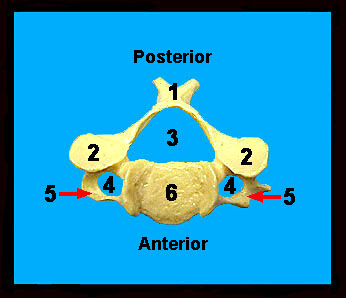|
|
|
|
||||||||||||||||||||||||||||||||||||||||||
|
In humans (as in most mammals) there are seven cervical vertebrae that support the neck. These vertebrae are distinguished from those of other regions of the spinal column by having a transverse foramen in each transverse process. The first two cervical vertebrae are specialized for articulating with the skull. The atlas (C1) lacks a body and spinous process, and its superior articulating processes (facets) articulate with the occipital condyles of the skull, permitting the head movement used in nodding "yes". The axis (C2) has a spinous process and a body called the odontoid process (dens) that protrudes into a groove on the atlas. The axis permits the rotational movement of the skull used to indicate "no". |
|
